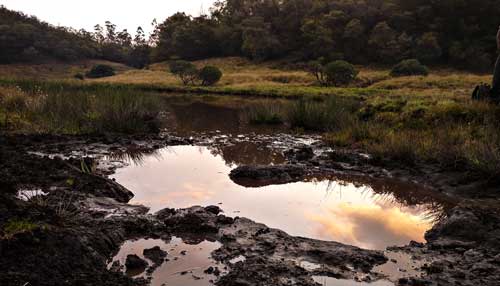|
ZOO/WILD's
2013-2016 Activities . . .
Evaluation
of the Amphibian Chytrid Fungus (Batrachochytrium
dendrobatidis) on the
amphibians of the Western Ghats.
First of all… Why is this study
essential?
The Western Ghats, is a stretch of
forests parallel to the west Coast of
India. It is among the 34 biodiversity
hotspots of the world owing of its high
diversity of endemic species, most of
which are under threat because of
several human influenced factors. The
Western Ghats is rich in amphibian
diversity with 182 known species of
which 160 species (88%) are endemic to
this region. This zoogeographical area
hosts five freshwater eco regions
encompassing thousands of streams and
other water bodies. As per the IUCN red
list of threatened species more than 43%
of amphibians are threatened with
extinction. They are either Critically
endangered (CR), Endangered (EN) or
Vulnerable (VU) due to anthropogenic
factors such as habitat destruction and
confined populations.
Information on diseases which pose as a
threat to amphibian populations is
inadequate. Chytridiomycosis is a
dreaded fungal disease of amphibians,
which threatens more than 200 species of
amphibians across the globe, with
extinction. There is a single report of
the disease from Western Ghats,
published in 2011.
So, this project aims to fill in the
information gaps on the extent of
occurrence of the disease, infection of
the disease and its effects on amphibian
populations.
Brushing up basics ….
What are amphibians and why is it
important to conserve them?
They are cold-blooded vertebrates which
consist of Frogs, Caecilians and
Salamanders. Unlike humans they lack an
inner temperature regulation system and
they maintain their body temperatures by
changing their position according to the
environment. Water is an essential part
of their systems, as it helps in
regulating the mineral content of their
body systems, so minor changes in
mineral compositions of the surrounding
environment can result in death. Thus,
they act as indicators of ecological
health.
What is Chytridiomycosis?
It is a fungal disease caused by the
Amphibian Chytrid Fungus (Batrachochytrium
dendrobatidis). This fungus grows
on the skin of amphibians, and blocks
the inner mechanisms helping in water
regulation of the amphibian body. As an
end result it leads to internal bleeding
and a heart attack. It was first
reported in 1997 from Panama on the
Golden frog (Atelopus zeteki) and
is now estimated to threaten more than
200 species of amphibians out of the
6000 known species, with extinction.
How does it spread?
It produces zoospores which are carried
by water, making amphibians more
susceptible than other organisms.
Are there carriers for this fungus?
Yes, like how mosquitoes are carriers
for diseases such as malaria, two
species of frogs, the African clawed
frog (Xenopus laevis) and the
American bull frog (Lithobates
catesbianus) are vectors of this
fungus.
They have in-built immune responses
which fight the fungus and as these
frogs are highly exported throughout the
world for aquariums, and frog leg trade
they act as reservoir hosts to spread
the disease.
What can be the origin of this fungus
in Western Ghats?
Presently, the answer is unclear, but
there is a recent increase in the import
of the African Clawed Frog (Xenopus
laevis) in the last two years via
the aquarium trade and reports indicate
the release of these frogs by careless
hobbyists into the wild leading to the
spread of this fungus, which could be
one of the reasons for the spread
of fungus within the Western
Ghats.
What is the role of WILD to study
this disease?
We at WILD are conducting surveys across
the Western Ghats to collect information
on the occurrence of the disease using a
non–invasive swabbing technique.
Our main objectives are:
- To standardize a non–invasive field
sampling protocol with quarantine
procedures.
- To standardize laboratory processing
protocols to check for the presence or
absence of the fungus.
- Establish long term monitoring
protocols.
- Formulate a policy document for the
Government of India on import of
exotic trade within the country.
- Generate maps on the incidence of
the disease.
On-going work at WILD:
There are various activities which have taken place as a part of the Amphibian-Chytrid Project this year. The DNA extraction and analysis from swab samples collected until 2014 was initiated and DNA has been extracted from a total of 2100 swab samples. Apart from this DNA extraction and analysis was completed from amphibian specimens from WILD museum and manuscripts on the results of this component of the project are currently being prepared. Field surveys to collect specimens for taxonomic studies was conducted at Ranipuram Vested Forest in Kerala and at areas around Mookambika Wildife Sanctuary. Ground work for preparation of an amphibian field guide is presently underway for which information was compiled and diagrams were prepared. Also, for the Amphibian assessment due in 2016, species accounts was compiled. Protocols for conduct of a population monitoring study at an organic coffee plantation at Coorg is currently underway.
I am interested to join in surveys, can
I?
Yes, you can. But, you need to understand
that this is serious work involving strict
quarantine procedures and night surveys.
We need people who will be responsible
about themselves and can handle basic
instruments like a GPS and a pH meter. It
will be an added advantage if you are a
good photographer.
I have understood to an extent about
this infection, is there anyway I can
help?
Oh yes, you can.
Don’t buy exotic animals as pets, they
mess up ecological balance when released
into the wild.
Report any fishy incidence of mass deaths
of frogs or toads which you come across.
You could write to us at wild@zooreach.org.
Click and share photographs of any
infection on amphibians which you come
across like a disfigured limb or a piece
of skin coming out. And most importantly,
don’t forget to pass on the information.
For more queries contact us at wild@zooreach.org.

|